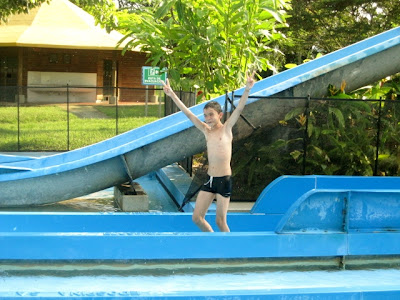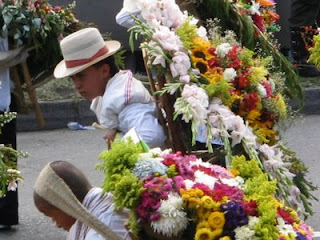Medellín is a great place to
live, and many people agree that it has the highest quality of life in
Colombia. Posters and notices seen all
over Medellín proudly proclaim that the City of Eternal Spring is currently competing
with Tel Aviv and New York City as the Wall Street Journal’s City of the Year.
You don’t have to look far to understand
why Medellín has been recognized around the world for its innovation. The list is endless… the modern metro system,
the numerous new public libraries in the poorest parts of the city, the new
green transportation initiative including a new tram line and a public bike-share program, the cable car system integrated into the metro that allows residents
from poor hillside barrios easy access to the rest of the city, and the world’s
first outdoor escalator system designed for public transportation for residents
of extremely steep neighborhoods.
In addition to continuous improvements in
the city’s infrastructure, Medellín’s city planners always try to preserve as
much green space as possible and connect the city to the forests, mountains,
and countryside that lie just beyond the city’s borders. Indeed, in many parts of Medellín it feels as
if a city was planted on top of an existing botanical garden.
None of the children from this particular one of Globalteer Colombia's partner projects had ever visited the park before, so Globalteer recently
organized a day trip for them. Twenty of
the children excitedly gathered in the foundation with their backpacks filled
with snacks, packed lunches, and bathing suits.
With only one of the foundation’s staff and Globalteer’s Volunteer Coordinator
to chaperone the event, all of the older children were expected to help and
take the hands of the youngest so they wouldn’t get lost in the walk to the
metro station and the crowded metro system. There have been numerous excursions over the
years with the children of the three projects that Globalteer works with in
Medellín, and no one has ever been lost or misplaced.
Upon arrival at the final metrocable
station in Parque Arví, the group was met with gorgeous clear skies, bright
sunshine, and a park guide, free of charge to all visitors. The children couldn’t wait to dig into their
snacks and before the tour began insisted on devouring their chips, cookies,
and malt sodas.
They needed the energy, as they were unknowingly about to begin a three-hour journey into the wilderness. The chosen path took the group past a large national police outpost with expansive horse stables for the mounted police who patrol the park. Soon the pavement ran out and became a dirt road, with numerous old and rustic country houses dotting either side of the path. A bit further down the path, with the children already beginning to inquire about whether we’d reached our destination yet, the gravel and dirt changed into an old stone pathway, which the guide explained was made by the original indigenous inhabitants of the area, long before the arrival of Columbus.
 The group veered off the main road and into
the forest on a narrow path. The
children who had been complaining of fatigue after walking on the main road for
an hour all found renewed energy and began to run after each other on the path
through the forest, a gigantic natural playground. They ate lunch on some picnic benches deep
within the forest, and then as it began to gently rain the group arrived at the
charcos - what the children had been
waiting for. Soon the area and pathways
around the streams and small waterfalls were clogged with soaking and shivering
children. While Medellín enjoys a
springtime-like year-round temperature, Santa Elena lies at a higher elevation
as it’s outside of the valley that Medellín inhabits, and for this reason can
be a lot cooler than the city. The
freezing cold water that the children were happily swimming in didn’t deter
them, and most spent more than an hour jumping into the shallow pools and
sliding down the slippery rocks of the rapids.
The group veered off the main road and into
the forest on a narrow path. The
children who had been complaining of fatigue after walking on the main road for
an hour all found renewed energy and began to run after each other on the path
through the forest, a gigantic natural playground. They ate lunch on some picnic benches deep
within the forest, and then as it began to gently rain the group arrived at the
charcos - what the children had been
waiting for. Soon the area and pathways
around the streams and small waterfalls were clogged with soaking and shivering
children. While Medellín enjoys a
springtime-like year-round temperature, Santa Elena lies at a higher elevation
as it’s outside of the valley that Medellín inhabits, and for this reason can
be a lot cooler than the city. The
freezing cold water that the children were happily swimming in didn’t deter
them, and most spent more than an hour jumping into the shallow pools and
sliding down the slippery rocks of the rapids. Most of the children at this project live in one of Medellín’s dirtiest inner-city districts, an area filled with car repair workshops, lumber shops, and not a trace of greenery. Fortunately for the kids, it is easy to get out of this area and find themselves in a place like Parque Arví.
While it would take more than an hour to
escape from the concrete jungle of Bogotá, residents of Medellín have nature
all around, and a 15-minute trip in any direction will take you outside the
city and give you access to a never-ending natural playground of nearby hiking
trails, waterfalls, creeks, lakes, charming small towns, and nature preserves. It’s no wonder that people in Medellín are
very connected to nature. While they
love their city, most never miss the opportunity to visit a small town, ride a
horse in the hills, or spend the weekend at a finca, or country house. The
opportunities for day trips with Globalteer Volunteer Colombia children's projects are endless. Now the kids
from each project have made a trip to Parque Arví, and Globalteer staff and
volunteers are often asked when they can go again. Will
you join them on their next excursion?







small.jpg)
small.jpg)
small.jpg)
small.jpg)
small.jpg)
























.jpg)




